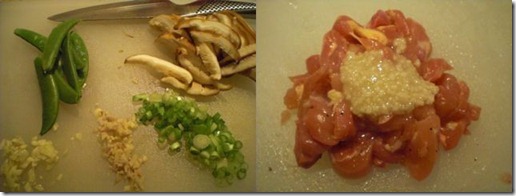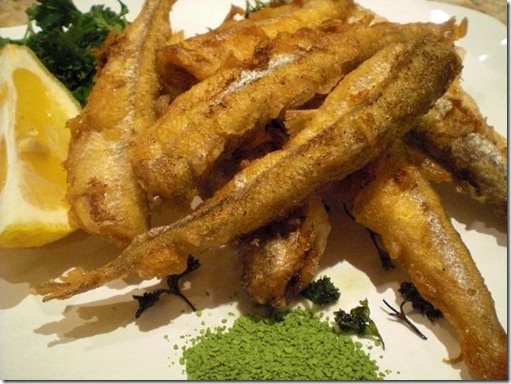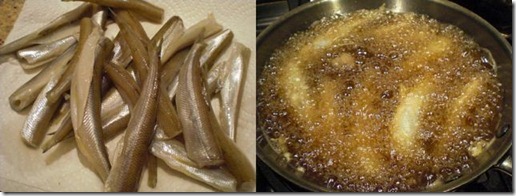As usual, I had the raw trimmings from two pork tenderloins leftover after cooking the tenderloins. I thought I would make something which I have not tried before. The idea of making a bean and pork stew dish came to me, which is along the same line as the quick lamb stew dish I make from cooked (leftover) lamb and kidney beans (I thought I posted this but apparently not). My wife objected to a Boston-style baked bean-type dish pointing our that the pork usually used in that dish was salt port not pork trimmings. So, we decided to try making the leftover trimmings into “cassoulet”. Remembering how Anthony Boudain made this in one of his shows and consulting a few recipes on line, I came up with this quick and simplified (and less deadly) recipe. It is mostly based on “
Weekday cassoulet” recipe from the food network web site. Although it is titled “Weekday”, I made this on the weekend.
Although the traditional recipe used a wide variety of meats and copious amounts of bacon, I restrained myself and only used one strip of bacon, plus some chicken thighs I had in the fridge and the leftover pork trimmings.
I used:
- Pork tenderloin trimmings (about 1/2 pound, cut into small bite-size chunks)
- Chicken thighs, skin-on and bone-in (4, excess fat and skin trimmed)
- Bacon (1 strip).
- Onion (1 medium, finely chopped)
- Celery (3 stalks, finely chopped)
- Garlic (4 cloves, finely minced)
- Carrot (1 medium, finely chopped)
- Bay leaves (3)
- Dried thyme (1/2 tsp)
- Dried French tarragon (1/2 tsp)
- White vermouth (or white wine) (1/2 cup)
- Chicken broth (1/2 cup, non-fat, low-salt Swanson)
- Great Northern beans* (2 cans, 16oz each, drained and rinsed)
- Stewed whole tomato (1 can, 16oz, drained and crushed by hand)
*Great Northern beans is a type of white beans (Navy beans) and similar to cannellini and grown predominantly in Minnesota.
For the bread crumb mixture which goes on the top (I don't think this is essential). I used
- Japanese Panko (1 cup)
- Parsley (finely chopped, 2 tsp)
- Garlic (1 clove, finely chopped)
- Olive oil (1 tbs)
I mixed them up in a small bowl by rubbing them between the fingers and set them aside.
Of course, you can use different varieties of meat such as duck or duck confit, mutton, pork, goose and sausage. If you start with dried white beans and tough cuts of meat, you need a much longer time to cook.
I seasoned both the pork and chicken with salt and pepper (I got a fancy salt assortment this Christmas and used “smoked” sea salt. When ground, it gave off smoky aroma). I used a deep Pyrex baking dish/pot with a glass lid. On low flame, I cooked the bacon which was cut into 1/2 inch pieces and cooked it until the fat rendered and it became crispy (for about 5-7 minutes). I removed the bacon and set it aside but left the bacon fat in the pot. I then browned the pork and chicken in small batches on medium flame which took a good 15-20 minutes.
I removed the pork and chicken from the pot and set them aside. The chicken did render more fat but I judged the amount of the fat was just right and did not remove any fat from the pot. I then sautéed the onion, celery, carrot, and garlic for 3-4 minutes until soft, seasoned with salt and pepper. I then deglazed with white vermouth and reduce it for 5 minutes. I added the white beans, tomato, bay leaves, thyme, tarragon and and chicken broth. I then put back the pork, chicken, and bacon nestling the pieces into the beans and vegetables.
I baked it with a lid on in a preheated 350F oven for 50 minutes. While it was in the oven we grabbed the wine (see below) and the timer and retreated from the kitchen to imbibe the wine while watching a winter sunset (a great way to cook).
After 50 minutes, I removed the lid and spread the crumb mixture on the top and put it back into the oven on broil setting until the crumbs got nice and golden (picture below).

This dish is comforting beyond belief. The beans have a wonderful flavor and texture. The varieties of meat add a complexity and unctuous mouth feel. With the long cooking time the chicken fell off the bone and the pork was fork tender. It was absolutely perfect for a cold winter's night. This will definitely be a regular on our menu. Since it seems there is no end to the combination of meats you can use, the numerous variations of this dish will make it continuously interesting. This is also one of those dishes that is better the next day. It made a very good leftover of the leftovers.
We had this with a bottle of Pinot Noir, which is very unusual for us since we usually do not particularly like Pinot. This one is from
Santa Lucia highlands near Monterey,
Caraccioli Pinot Noir 2008. As far as we can tell, this one got high marks (reportedly 93 by RP). We bought half a case for Thanksgiving and Christmas. It went very well with the cassoulet but, still, we had to admit that we are not Pinot aficionados.
















